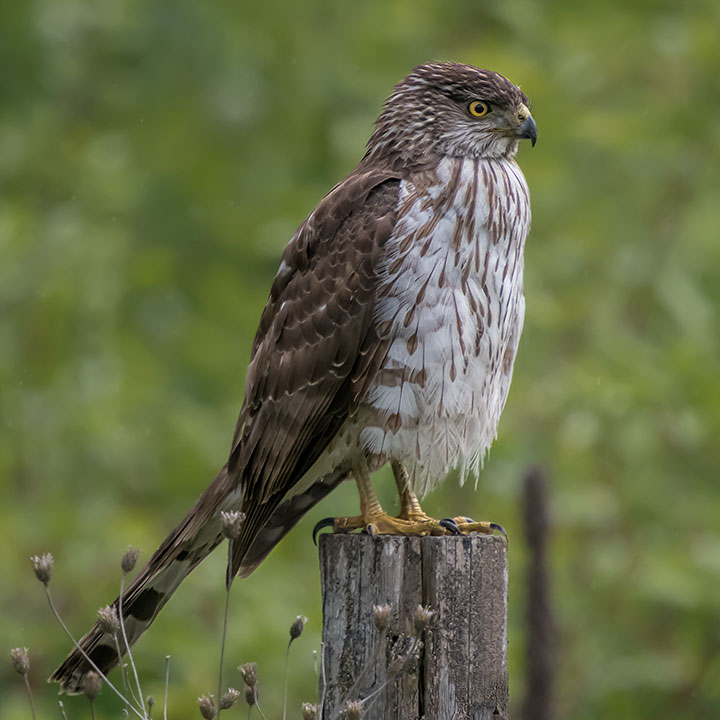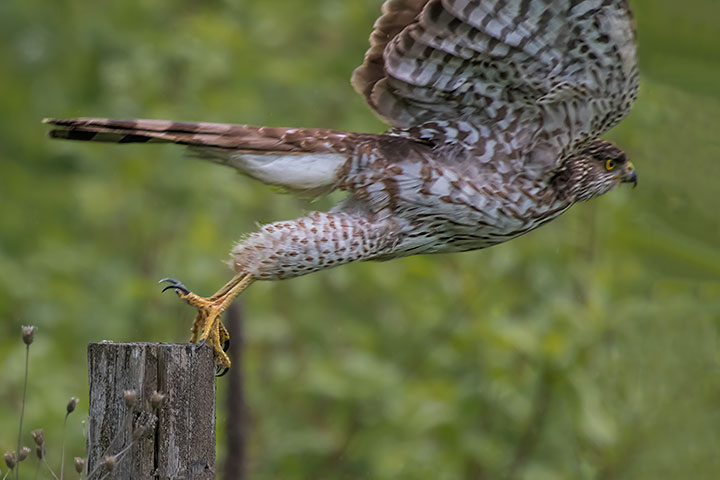Four months ago, I posted a picture of a hawk in the genus accipiter and turned to my readers to help identify it. The sentiment was that is was a Sharp-shinned Hawk, rather than the larger Cooper’s Hawk (the other likely choice). The problem has occurred again, but this time I managed a much better picture or two.
This time, the accipiter is a juvenile, and once again, I think it is a Sharp-shinned Hawk, but I can see conflicting evidence in that while the tail looks like the sharpie, the breast looks like a Cooper’s. So, I am at the mercy of those who are willing to comment.
When spotted, the hawk was hunting from a fence post.

It soon flew off, and so allowed a different view.


Ah — those wonderful leggings are worthy of a gyrfalcon but we’re too far south for that fellow.
Have you considered peregrine, prairie falcon, or red tailed hawk?
Great shots
Wendy
The top photo is really good. I think you are right Alistair. The white terminal band on the tail is very thin. The head looks small even with all the feathers puffed out. The legs and body look thin and slim. Also the angle and light on the right leg in the top photo make me think I can see the sharp shin.
Two people have written me directly, each suggesting that this bird is a Cooper’s Hawk.
First assessment:
Well I could be dead wrong about your hawk, Alistair, but there are a few things about it that suggest a Cooper’s, to me. The tail, proportionally, seems a little bit longer than I would expect a Sharpie would have, and the bands are pretty wide on it—plus the head, proportionally, seems a bit larger than I would expect a Sharpie’s to be… therefor my call—for what it’s worth— is a Cooper’s.
Second assessment:
As for your Accipiter: I’m sure you realize that this is perhaps a most contentious pair of common birds, and possibly the most miss-identified. I’m going to go with Cooper’s for the following reasons:
* head looks about right size for the body – Sharpie has a small head that can appear ‘undersized’
* head has a faint suggestion of a flat top and slight angle at the back – as if slightly crowned; Sharpie has a very round head
* lower breast streaks are narrow, sharply defined, dark brown in colour; by contrast, Sharpie’s streaks are broader, diffusely margined, and more rusty toned
* with some imagination, I think I see overlapping of tail tips: Coop tail feathers are shorter on outside, longer in middle, so the tips overlap when folded – when this is clearly observed it is definitive
* the feet are large and powerful-looking, with sturdy legs; Sharpie is known for having spindly legs and small feet
* the white tail tip is narrow, but this could well be due to wear, so not too helpful
I think the best mark in this example is the nature of the breast/belly streaking.
These are very good reasons and I could well be wrong. This is one of the most difficult ids in birding especially from just a photo. A flying bird in real life is an easier id for me.
The bird still looks too slim and small for to me for a coopers. The tail could be worn by now. The bird hatched last year and will soon begin molt. But the rest of the bird doesn’t look worn much at all, and usually the width of the terminal band is a reliable indicator-especially so after the molt.
Give us an easier shot next time Alistair!